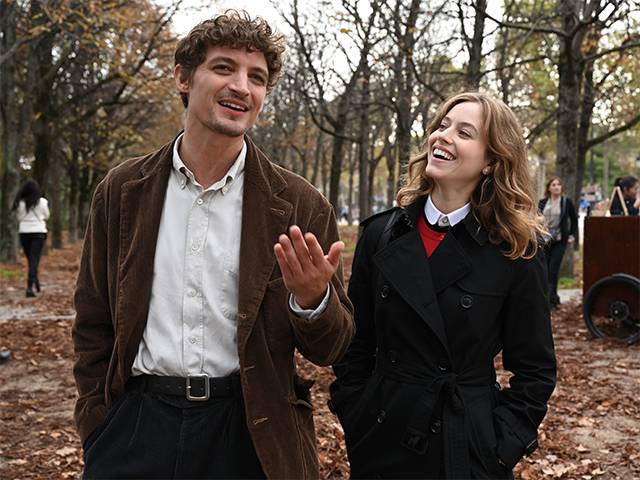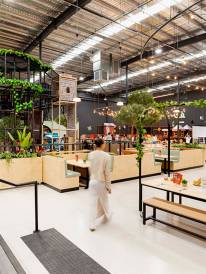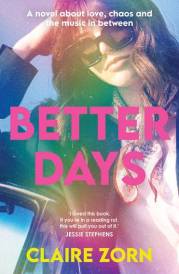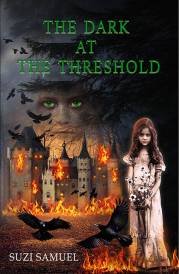Coup De Chance

Although Woody Allen's filmography is unquestionably associated with New York City, Paris has always had a special place in the filmmaker's heart. After he filmed –in part –EVERYBODY SAYS I LOVE YOU in Paris in 1996 and he made the French capital into a character in its own right in MIDNIGHT IN PARIS in 2010, he returns to the City of Light this time around for a film entirely shot in French. Originally, however, he considered doing COUP DE CHANCE in English and thought the protagonists would be Americansliving in Paris. "I don't really speak French and I understand even less, but as I finished the script, I thought that it would be a great experience to make it in French," says Allen. "I've always been in love with the European cinema and the French cinema very strongly, and when I suggested that I make it in French to my producers, they responded enthusiastically."
So, we meet Paris-based Jean (Melvil Poupaud) and Fanny (Lou de Laâge), a glamorous and wealthy couple living in a splendid, typical Haussmannian building in the west end of the city. Jean is a charismatic, highly successful businessman –even though some of his friends hint, jokingly or out of jealousy, that he has benefited from his partner's sudden passing. Because not only is Jean a charming character, but he most importantly likes to feel that he's in control of things, sometimes even making his own luck. "Many successful businessmen feel that they make their own luck and that they're not at the mercy of chance," the director continues. "Luck is not the whole thing by any means, but Jean is the controlling kind so much so that, as we find out early on, he may have extended himself into illegality to get rid of his partner."
After she had a painful marriage and eventually broke up with her first husband, Fanny, unnerved by her failed marriage, was attracted to Jean who appeared as stable and reliable. "This attractive, wealthy man came along at a good time in her life, just as she felt confused and needed to be comforted," says Allen. "She let him take over her life in a way that was generous and comforting to her. She liked it but if she had met him under less stressful circumstances, perhaps she would not have necessarily married him."
Fanny gradually realizes she's not at home with her husband's shallow crowd of people and that it's boring for her to spend weekends at his country estate, hunting and playing golf. "She's a bright, cultivated young woman who's always had an artistic leaning and thought of herself as marrying a musician, a painter or a writer," adds the filmmaker. "Actually, she married one and he turned out to be artistically stimulating –and If her first husband hadn't been a druggie, she would have remained in the world of art."
When she accidentally bumps into Alain (Niels Schneider), a former classmate turned writer, in the street, Fanny is swept off her feet. Not only does it rekindle his attraction to her, but she realizes even more acutely that she's not living the life she was intended for and that she has become, to Jean, a kind of trophy wife he's proud to show off to his friend circle. "Alain has very little money, so he lives in an inexpensive attic apartment of sorts, but his lifestyle resonates with Fanny's Bohemian spirit," says Allen. Unlike Jean, Alain is acharacter that embraces chance and luck –a theme that is recurring in the director's work, as in MATCH POINT. "Alain appreciates the influence of chance and luck in life –he has observed it and has lived it, unlike Jean who is a much more controlling, rigid personality," adds the director. "My feeling is that luck and chance play a much greater role than people care to admit –they like to think that if they work hard, if they apply themselves and discipline themselves, they will be able to control their lives. But it is only partly true, even if it is a slightly unnerving thought."
Jean hasn't only charmed Fanny –he has literally won over her mother (Valérie Lemercier) who has a lot in common with him and who is relieved that her daughter is safe living with a stable, rich man. "She likes him very much," the director admits. "They're both very outdoorsy –they like fishing, hunting and hiking, and she's happy that her daughter married someone who's stable. As a matter of fact, Jean and Fanny's mother are two people who are very much alike." However, her mother's instinct kicks in when she hears a remark and feels her daughter may be in danger –and she becomes very suspicious of Jean. "She hears things about her son-in-law, and, unlike Fanny, she follows up on the gossip," says Allen. "In the beginning, she only has a vague feeling of suspicion but she's more and more worried and she decides to investigate as she feels there is something amiss."
While the romantic plot and the themes are deeply felt, working with actors in a different language than English was a dramatically new experience for the director. "I speak only English, so I never thought I'd get a chance to work in another language, but I found that it was fine because you can tell if a personis acting believably or acting not believably," says Allen. "And I wrote the script, so I know what they're saying in every scene. So, if I feel somebody made a mistake, I can ask the script supervisor and the cameramen that do speak the language." Allen admits that he didn't know any of the actors playing in COUP DE CHANCE, but that all the cast members he picked out from videotapes were first-rate actors and appropriately correct for the parts. He was introduced to them briefly prior to the shoot and, aswith all of his collaborators, he let them have an enormous amount of creative freedom. "I wanted them to be able to put things in their own words and speak as regular French citizens," adds the director. "They didn't have to obey my script in a rigid way–they could relax and improvise and speak as they would speak under similar circumstances. When you give them such freedom, you get fine performances."
The cinematography and the various colors, from warm and golden hues to colder tones, enhance the city's beauty and express the characters' emotional journey. COUP DE CHANCE marks the fifth time that Allen has collaborated with cinematographer Vittorio Storaro, after CAFÉ SOCIETY, WONDER WHEEL, A RAINY DAY IN NEW YORK and RIFKIN'S FESTIVAL. "Most of the trick to make a good picture is surround yourself with first-rate collaborators," continues Allen. "You need to pick them out appropriately and then don't sit on top of them –let them express themselves artistically. With Vittorio, we always work the same way. He reads the script, we have a conversation about what the feeling of the picture should be, and as with all of my collaborators, I give him an enormous amount of freedom. He's a great artist and almost everything he does naturally is beautiful." Storaro decided to go with a Sony Venice 16-bit digital camera that delivers unparalleled resolution and image quality. "I don't miss film at all," says the cinematographer who lensed most of Bernardo Bertolucci's films and Francis Ford Coppola's APOCALYPSE NOW. "With this camera, you can capture up to 200 billion different hues! For COUP DE CHANCE, we were shooting in Paris which is essentially a northern city, and we were shooting in the fall season, which meant it was mostly cloudy and the entire city was using artificial lights. So, for the most part, I used the contrast between artificial and natural light according to specific moments."
Just as he usually does, Storaro sought to emphasize visually the opposition between the two protagonists. "I connected warm tonalities with Fanny, using the beautiful midday light or the warm light of the sunset as these are the moments when she meets with Alain," the director of photography explains. "To enhance Fanny's sense of freedom, I mostly filmed her with a Steadicam and went with a longer lens connected to her. It was quite the opposite with Jean as he's associated with the moonlight and so I filmed him with a very wide angle, showing that he practically moved in a very straight line." Likewise, he wished to give the gorgeous Parisian apartment –Jean's ultimate territory –a bluish tone that intensifies as the tension builds. "In fact, the walls of the apartment were white," adds Storaro. "But I realized that if I let the natural light filter through the windows and if I set the camera in 'artificial mode', the walls came out bluish. Woody was sold by the idea even if he wanted a very light blue at the beginning and a darker blue at a later juncture. I showed him he needn't worry as you could increase the bluish tonality by increments."
Just like Storaro's cinematography, the places and neighborhoods of Paris visited by the characters offer an idealized vision of the city –that of Woody Allen's. Once again, the director gave much leeway to production designer Véronique Mélery who had never worked with him before and did not give her specific references. "We mostly had a conversation about the characters and their psyche, but I quickly realized that he wished to showcase the Paris he loves and film the city in all its glory," says Mélery. The Luxembourg Garden, the classically beautiful grand avenues of the West End, the Montmartre neighborhood already featured in MIDNIGHT IN PARIS all relate to the director's personal memories. The country house turned out to be slightly more challenging. "We'd visited the house on the first day of scouting", she continues. "The place's obvious charm and soul, and the surroundings were perfect. But Woody wanted to find a place closer to Paris. So, we went back to scouting but never found the ideal location and after weeks of research, we happily came back to our initial choice."
For the interiors, Mélery saw again MATCH POINT and MANHATTAN MURDER MYSTERY, which share a crime plot with COUP DE CHANCE, to get immersed in both films' atmosphere. However, she admits that at the outset her cultural references clashed a bit with Allen's. "His vision of rich interiors, which was very American, was challenged by my own vision, as a French woman, of a young Parisian couple navigating the high society," she says. "Woody embraced this representation and trusted me completely." For Jean and Fanny's apartment, a mirror of the couple's flawless, attractive façade, Mélery and her team sought for the furniture at the famed Clignancourt Flea Market, from Paris antique shops and foreign dealers that offered original pieces in tune with the characters' cosmopolitan culture. The many artworks one can spot in the apartment were either created by the crew –that found their inspiration in classic pieces –or lent out by private collectors. The restaurants that play a major role in the film were picked out because the director knew them and liked them. "Some were typical of the Parisian bistrotand others were trendy places offering a panoramic view on the city," says Mélery. Other locations were found quite by accident, in a nod to the film's main theme! "I had visited the Guimet Museum for the exhibition galleries and the rooftop terraces and we went through the offices just to avoid any future regrets," she adds. "When I saw the archive boxes, the detective's office appeared as an obvious choice –you could picture a family-operated business with investigations files sorted in all those boxes that had been going on for generations! Woody had a more unassumingoffice in mind, but he liked the natural beauty of the location. Jean's office was found in the same building that was also picked out because we just fell for it. I asked an artist to paint the backdrops that have Jean immersed in a forest –another major 'character' of the film!"
Just like the locations and the production design, the costumes, in their own way, help tell the story and emphasize the moments of tension and emotion. As a six-time collaborator with Woody Allen, costume designer Sonia Grandehas developed a professional shorthand with the director, so that she knows instinctively what he likes. "There are certain colors he doesn't like, and the wardrobe must have a light, drawn appearance," she says. "He doesn't like excessive layers of clothing over the actors' bodies, covering or sheltering them too much." As for the director, he trusts Grande totally. "I've worked on a number of pictures with Sonia and I let her express herself artistically," he notes. "If an actor or actress comes in wearing something that I feel is wrong, I'll tell Sonia, but that's rare. If you let a collaborator such as her do what she wants to do, because she understands the script so well, nine out of ten times what she wants to do instinctively is correct." For Jean and Fanny, it was about showing the couple's social status and good taste through their outfits, shoes and jewelry. As far as Fanny is concerned, she first boasts a sophisticated, elegant look that grows simpler and more unassuming as she gets closer to Alain. "Her look is more laid-back as if, in a way, she was returning to be the girl she used to be before she married Jean," says Grande. Conversely, Jean is very image-conscious and wants his style to convey his power. "We worked with high-end brands including Hermès, Zegna and Ralph Lauren to achieve her character," Grande adds. For Alain, the costume designer meant to avoid disguising him as Bohemian and went for a genuine look instead. The collaboration with Niels Schneider turned out to be key. "I wantedto show that this is a young man who traveled quite a lot and who is very cultivated although he has virtually no money," says Grande. "I needed the character's style to come out very directly from the actor's personality. We purchased most of the clothesfrom the second-hand market and Niels made them his own immediately –and his natural charm did the rest."
Woody Allen had a wonderful experience shooting a film in Paris in French and he'd be happy doing it again. While he kept the same methods that heuses when he shoots in the US and has worked with many of his long-standing collaborators, he made an exception for the soundtrack. "Usually in all my pictures I have a much older jazz music which is the music that I like," he concludes. "But since I was making a French picture, I paid an homage to the French cinema of the 1950s and 1960s, like Louis Malle's ELEVATOR TO THE GALLOWS that I discovered when I first became aware of the French cinema. French filmmakers at the time used Miles Davis and the Modern Jazz Quartet and a kind of modern jazz in general. So, that's the style I used for COUP DE CHANCE and it worked out very well."
MORE



